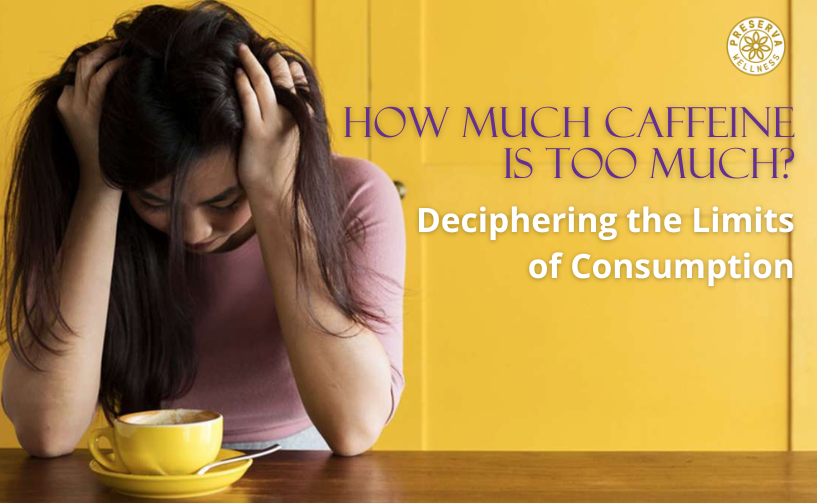Do you kickstart your day with that refreshing cup of coffee or tea, relying on the caffeine infusion to propel you into the hustle and bustle? The allure of caffeine is undeniable, but have you ever pondered the intricacies of your consumption and its impact on your well-being?
Let's embark on a comprehensive exploration of caffeine – its origins, effects, and the potential health hazards it may pose.
-
Unveiling the Caffeine Contenders: Natural and Added Sources
Caffeine, a natural stimulant, finds its home in various plants. From the beloved coffee beans to the soothing embrace of tea leaves and the decadence of chocolate, nature offers diverse sources of this energising compound. Yet, caffeine extends beyond these classics, making appearances in alternative teas like yerba mate and flavourings such as guarana. As if that's not enough, food and beverage manufacturers often augment products with caffeine, creating a landscape where the stimulant is omnipresent.
-
Deciphering Caffeine Content: Labels, Brews, and Surprises
Quantifying caffeine content can be akin to navigating a maze. While packaged foods and drinks often disclose their caffeine levels on labels, the ambiguity arises with brewed beverages. The coffee beans' origin, processing methods, and brewing techniques all play a role in the caffeine content. For those seeking precision, online databases can offer estimates. A 12-ounce soda can wield 30-40 milligrams, while an 8-ounce cup of tea spans 30-50 milligrams, and coffee's caffeine punch can range from 80-100 milligrams per 8-ounce cup.

-
The Deceptive Charm of "Decaffeinated": Lower, but Not Absent
Many people believe that "decaffeinated" beverages are completely free from caffeine, but that's not entirely true. The decaffeination process involves removing most of the caffeine from the coffee beans, but it's impossible to remove all of it. As a result, decaf coffee and other decaf beverages still contain some amount of caffeine, although the levels are significantly lower than their regular counterparts. Typically, an 8-ounce cup of decaf coffee contains anywhere from 2-15 milligrams of caffeine, depending on the brand and brewing method.
If you're sensitive to caffeine, it's important to note that even small amounts of caffeine can trigger symptoms such as jitters, anxiety, and insomnia. Therefore, it may be safer to avoid caffeine altogether, including decaf beverages. However, if you enjoy the taste of coffee or tea but want to cut back on caffeine, decaf options can be a good alternative. Just be sure to check the caffeine content before making your choice.
-
Tailoring Caffeine Intake: FDA Guidelines and Beyond
Understanding the Goldilocks zone for caffeine intake is crucial. The FDA recommends a cap of 400 milligrams per day for healthy adults – that's roughly four or five cups of coffee. However, the intricacies lie in individual sensitivity, influenced by genetics, medications, and health conditions. Special populations, such as pregnant or breastfeeding individuals, are urged to tread cautiously, with the American Academy of Pediatrics advising against caffeine for children and adolescents.
-
The Telltale Signs of Overindulgence: Recognising Your Limits
When you consume an excess amount of caffeine, it can trigger a range of unpleasant side effects. These side effects may include common jitters that make you feel uneasy and restless. You may also have trouble sleeping, which can lead to insomnia, and you may feel anxious and nervous. Your heart rate may increase, sometimes to an alarming rate, which can cause an irregular heartbeat. You may also experience gastrointestinal problems such as an upset stomach, nausea, and vomiting. Headaches are also a common symptom of caffeine overconsumption, and they can be severe and persistent. Additionally, consuming too much caffeine can lead to a persistent feeling of unhappiness, which can linger for several hours after consumption. If you experience any of these symptoms, it's essential to recalibrate your caffeine intake to avoid further complications.
-
Beyond Moderation: The Perils of Excessive Caffeine Consumption
While moderation is generally the key to unlocking the benefits of caffeine, excessive intake comes with perils. The FDA sounds a warning about the toxic effects that can manifest with the rapid ingestion of approximately 1,200 milligrams of caffeine. Particularly ominous are highly concentrated caffeine products, often labelled as dietary supplements, capable of causing severe health consequences and even death.

-
Caffeine vs. Sleep: A Tug-of-War
Caffeine may give you wings during the day, but it's not a substitute for a good night's sleep. Acting as a stimulant, caffeine can indeed heighten alertness, but its effects are transient. Consuming it close to bedtime can disrupt sleep patterns, given its relatively long half-life of 4 to 6 hours.
-
Gradual Farewell: Taming the Caffeine Habit without the Withdrawal Blues
Are you considering a caffeine detox? Tread carefully. Abruptly severing ties with caffeine can lead to withdrawal symptoms like headaches and anxiety. Instead, opt for a gradual reduction in intake. Seeking guidance from a healthcare provider ensures a personalised approach to easing out of your caffeine dependence.
In essence, the world of caffeine is a captivating one, offering both pleasure and potential pitfalls. Armed with knowledge about your tolerance, caffeine's myriad sources, and the possible health risks, you can savour your favourite caffeinated delights while steering clear of the hazards that lurk in excessive consumption. Remember, the key to a harmonious relationship with caffeine lies in moderation and informed choices.
(Source: Food & Drug Administration)






